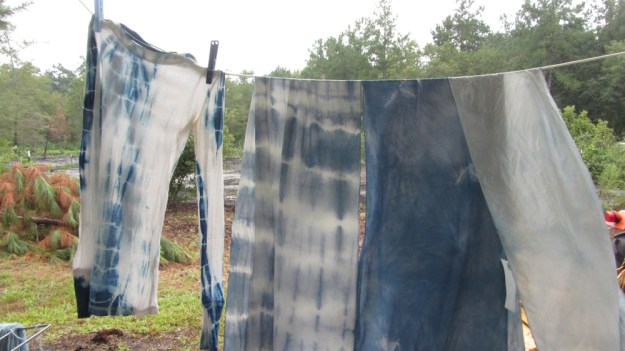 Heather Powers’s hands
Heather Powers’s handsFor days Two and Three of the Sea Island Indigo workshop*, we convened at Rebellion Farm, about 20 minutes west of my airbnb host in West Ashley. Donna Hardy was not kidding that she had grown us a field of indigo, and we began by harvesting.


 The straight-leafed crop in the three pictures above is Golden Rice, for which Carolina is famous. Indigo, below.
The straight-leafed crop in the three pictures above is Golden Rice, for which Carolina is famous. Indigo, below. 
 Right about the time I was taking this shot, fire ants were swarming all over my feet. They sting!! After a comic amount of swatting, I managed to get rid of them. Thankfully, only one managed to crawl above my knee.
Right about the time I was taking this shot, fire ants were swarming all over my feet. They sting!! After a comic amount of swatting, I managed to get rid of them. Thankfully, only one managed to crawl above my knee.
 We selectively harvested because some leaves were more ready than others.
We selectively harvested because some leaves were more ready than others.
 Donna is also growing Sea Island cotton (above and below). This variety has a longer staple and when woven, has the sheen and drape of silk.
Donna is also growing Sea Island cotton (above and below). This variety has a longer staple and when woven, has the sheen and drape of silk.
 I was lucky to be partnered for the day with fiber artist, Leigh aka Madame Magar (Charlestonmag.com article). After spending twenty years making hats, Leigh (below) is now designing funky, barely-constructed clothes and creating cloth-related installations. I encourage you to follow the link and see what she’s up to.
I was lucky to be partnered for the day with fiber artist, Leigh aka Madame Magar (Charlestonmag.com article). After spending twenty years making hats, Leigh (below) is now designing funky, barely-constructed clothes and creating cloth-related installations. I encourage you to follow the link and see what she’s up to.
 Leigh tending the pot
Leigh tending the potOur gas flame was exposed to a little draft and kept going out. For that reason, and perhaps others, our batch was fussy, non-compliant. This turned out to be OK because it meant we got to see how the experts make adjustments.



 Aeration method: pour liquid from bucket to bucket 100 times. Some in the group went to 500! After Leigh and I reached 200, we stood in line for the blender.
Aeration method: pour liquid from bucket to bucket 100 times. Some in the group went to 500! After Leigh and I reached 200, we stood in line for the blender.
 finally made myself an etui
finally made myself an etuiNotes: Shelley flings ‘garden snake’ off into the shrubs… black snake / smallish.
 We got a pounding rain the first afternoon, which sounded incredible on the pole barn’s roof!
We got a pounding rain the first afternoon, which sounded incredible on the pole barn’s roof!






 Tomorrow’s post will continue at the pole barn. You can read a nice narrative about the weekend here (Heather Powers’s blog).
Tomorrow’s post will continue at the pole barn. You can read a nice narrative about the weekend here (Heather Powers’s blog).
* * *
Sea Island Indigo Workshop took place September 18-21, 2014 in Charleston, SC. A field of indigo was grown for us by Donna Hardy, on Rebellion Farm, in Ravenel, SC. Fiber artist Kathy Hattori, of Botanical Workshops, flew in from Seattle to co-lead.























